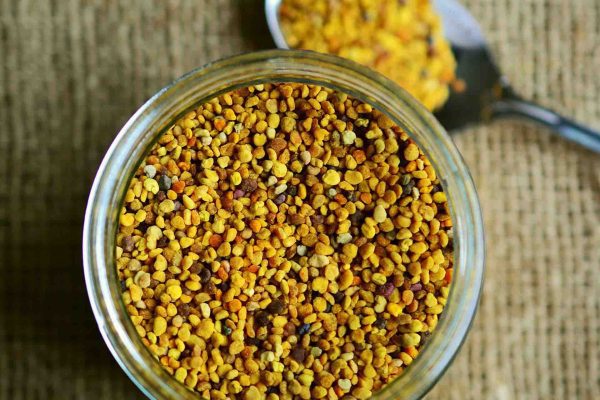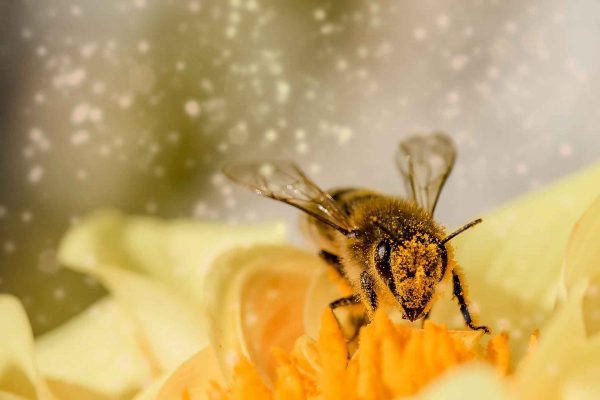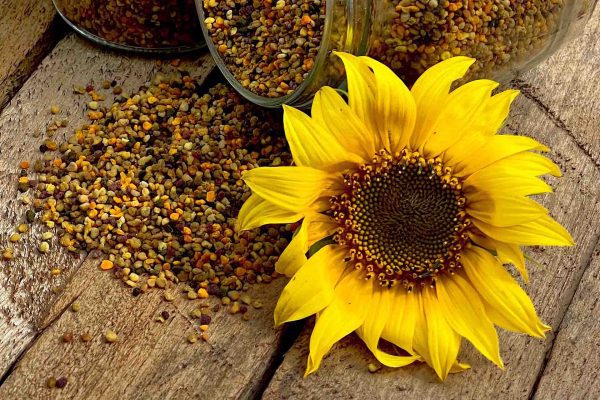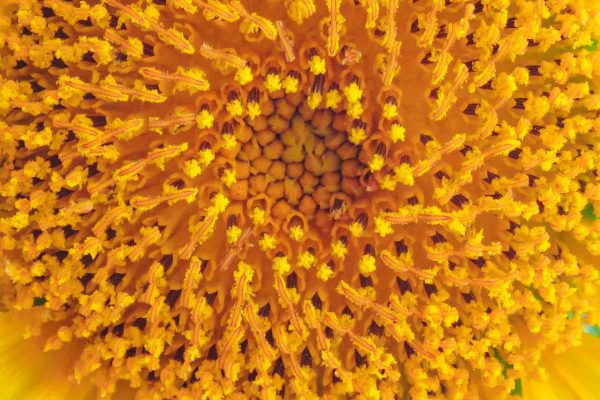BeesMAX sells pollen in its original raw form straight from the legs of the bees as it arrives at the beehive. We only sell 100% pollen by weight – be careful as many other products sold as containing pollen will have other ingredients that are not pollen.
We started selling raw pollen two years ago after being asked many times about allergies and asthma and how our honey can help to reduce those symptoms.
So although our honey contains pollen a greater desensitisation to those symptoms can be achieved by eating small quantities of raw pollen as a food supplement. How great the benefits are is difficult to define but we generally have really positive feedback and so have continued to supply it.
Not only does the supplement contribute towards desensitisation to the symptoms of allergies and asthma but it is a very good protein food supplement.
Bee pollen is a valuable vegetable protein of which approximately 40% by weight is protein. Up to half of its protein is amino acids that are ready to be used directly by the body. It contains more amino acids than beef, eggs, or cheese of equal weight.
The bees gather the pollen in a dust form and manipulate it into a solid mass, the granular form you see on their legs being carried back to the colony. It is those granules that we sell that you see in the jar. The pollen will tend to disperse and dissolve into the food it is used in. When added to food there is very little taste or texture to it
Pollen can also be sprinkled on salads or cold foods as a decorative dressing.
Background Research
Pollen is a plant material from flowers. It is commonly recognised main food source for bees and other solitary insects (Linskens and Jorde, 1997). However, it also consumed by humans in honey, as dietary supplements (Kostić et al., 2020) and as remedies (Ullman and Frass, 2010).
The fact that dietary supplements and remedies with pollen are produced suggests that there are medicinal and nutritional properties of pollen. This blog aims to explore these properties and highlight the medical benefits of pollen.
Consuming Pollen
People commonly consume pollen naturally infused within honey. An article by Linskens and Jorde (1997) which reviewed the literature regarding pollen as food and medicine, had described this. Generally, honey usually has pollen within it, which means that anyone eating honey will be eating pollen as well. The content of pollen in honey depends on the type of honey.
Using pollen to treat allergies
Even though many people are allergic to the exposure of pollen in the air, the pollen supplements can be used to prevent or treat these allergies when taken correctly. This is a concept that is referred to as “desensitisation” (or hyposensitization).
Ullman and Frass (2010), had described this as to “utilize small doses of substances that might cause symptoms in order to prevent or treat a hypersensitive state”. This was within their review which explored studies on clinical trials for remedies (including pollen) as treatment for respiratory allergies for this method.
Ullman and Frass highlighted historical links between homeopathic medicine and conventional allergy desensitisation treatment. Many of the clinical trials were published in “high impact” medical journals and described the effects of homeopathic treatment in allergic patients.
“Most of these clinical studies have been deemed to be high quality trials, according to the three most commonly referenced meta-analyses of homeopathic research. Basic in vitro experimental studies also provide evidence that the effects of homeopathy differ from placebo” (Ullman and Frass, 2010).
Pollen specifically has been given orally to patients suffering from pollen allergies as desensitisation treatment, and was implied that pollen may have an immunogenic effect (Linskens and Jorde, 1997).
Given this, and the previous section that explains that pollen is present in honey, it could be implied that consuming honey has this desensitization effect. In fact, research by Asha’ari et al. (2013) had found that honey at high doses improves the symptoms of allergic rhinitis, and could thus be used as complimentary therapy for this condition.
Other research had found similar results for pollen allergies, for example Saarinen, Jantunen and Haahtela (2010) used birch pollen honey and found it treated the allergy symptoms of the patients.
Nutritional properties of pollen
As well as being treatment and preventative of allergies, pollen has reported to have shown to hold nutritional compounds and shows “a significant biological activity, expressed as the antioxidant, antibacterial, and anti-carcinogenic activity and the hepatoprotective, and the cardioprotective effect” (Kostić et al., 2020).
This is due to its content of vitamins, carotenoids and polyphenols.
The vitamin content of pollen can contain up to 0.7% vitamins, such as lipophilic (vitamins A and E) and hydrophilic (vitamins in B group and vitamin C). The mean content of essential fatty acids can be around 0.4% (0.4 g/100 g). These were described by Kostić et al. in their review (2020) where they referenced a study by Komosinska-Vassev et al (2015).
The more prominent compounds with pharmaceutical potential are essential fatty acids, phospholipids, phytosterols, flavonoids, and phenolic acids.
Chemically, pollen can undergo changes depending on a significant fluctuations of environmental (e.g. humidity, oxygen, temperature etc.), as well as other factors (microbiological, chemical, physical, and mechanical) which can alter the nutritional content in the pollen before it is used.
Kostić et al., had reviewed that the shell of the pollen affects its digestibility of its nutrients. Therefore, the pollen should be grounded and placed into warm water where the accessibility of nutrients increases to 60–80% (Kostić et al., 2020). Nevertheless, pollen would still provide some of the nutrients even without this treatment.
Conclusion
This blog post’s review of literature has shown that pollen can be an effective treatment of allergies and has potential other benefits due to their nutritional content.
Therefore, consuming honey regularly, with the option to buy with added pollen granules, could be recommended to improve general health. BeesMAX is providing this option by selling their honey with the option to buy with added pollen granules.
References:
- Asha’ari, Z. A., Ahmad, M. Z., Jihan, W. S., Che, C. M., & Leman, I. (2013). Ingestion of honey improves the symptoms of allergic rhinitis: evidence from a randomized placebo-controlled trial in the East coast of Peninsular Malaysia. Annals of Saudi medicine, 33(5), 469–475. https://doi.org/10.5144/0256-4947.2013.469
- Komosinska-Vassev, K., Olczyk, P., Kaźmierczak, J., Mencner, L., & Olczyk, K. (2015). Bee pollen: chemical composition and therapeutic application. Evidence-based complementary and alternative medicine : eCAM, 2015, 297425. https://doi.org/10.1155/2015/297425
- Kostić, A. Ž., Milinčić, D. D., Barać, M. B., Ali Shariati, M., Tešić, Ž. L., & Pešić, M. B. (2020). The Application of Pollen as a Functional Food and Feed Ingredient-The Present and Perspectives. Biomolecules, 10(1), 84. https://doi.org/10.3390/biom10010084
- Linskens, H.F., Jorde, W. (1997). Pollen as food and medicine—A review. Econ Bot 51, 78–86 . https://doi.org/10.1007/BF02910407
- Saarinen, K., Jantunen, J., & Haahtela, T. (2011). Birch pollen honey for birch pollen allergy–a randomized controlled pilot study. International archives of allergy and immunology, 155(2), 160–166. https://doi.org/10.1159/000319821
- Ullman, D., & Frass, M. (2010). A review of homeopathic research in the treatment of respiratory allergies. Alternative medicine review : a journal of clinical therapeutic, 15(1), 48–58. A review of homeopathic research in the treatment of respiratory allergies – PubMed (nih.gov)



